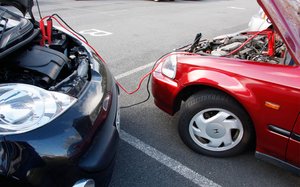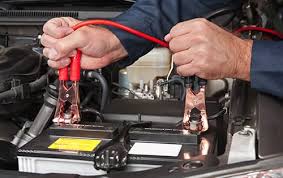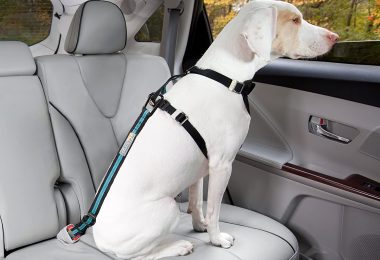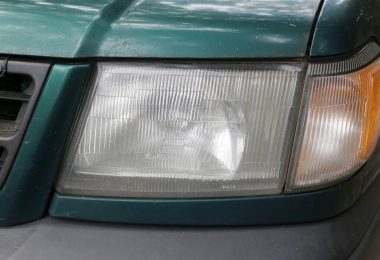
Common mistake that can blow off car brain box is what this article will be discussing. At the course of trying to use your car battery to start your car, there are some mistakes that usually happen. Sometimes, these mistakes are minor and cost less expensive parts in the car, while some error seems small but very expensive in purchase. Therefore, carefulness is very important
At the course of trying to use your car battery to start your car, there are some mistakes that usually happen. Sometimes, these mistakes are minor and cost less expensive parts in the car, while some error seems small but very expensive in purchase. Therefore, carefulness is very important so that on your eagerness to start the car, we don’t misplace the jumper wire’s polarity and then blow off the car Brain Box.Thereby, causing very big expense to our self. Therefore, the following tells you the process that can help you avoid the mistakes that can blow off your Brain Box.
Steps to Safely Jump-Start Your Car
- Safely park a car with a functioning battery in front of the one that is not functioning or beside as close as possible to your car. (Positioning could be face to face or side by side). Leave at least 18 inches of space between and never let the cars touch.
- For manual transmissions, place the car in neutral. For automatic transmissions, place car in park. Turn off engines, remove keys, and set the parking brake on each car.
- Get out your jumper cables. Make sure none of the metal clamps touch one another. Notice that each set of clamps has one red clamp and one black clamp.
- Open both car hoods. Locate the batteries and battery terminals. Terminals are usually covered in red or black, with a + or – sign on top. Make sure that you can identify which is positive and which is negative very important
- Attach the red cable clamp to the positive (+) battery terminal of the dead battery. Make sure there is a solid connection to terminal.
- Next, attach the other red cable clamp to the functioning vehicle’s positive (+) battery terminal.
- Now, connect the black cable clamp to the working battery’s negative (-) battery terminal.
- Do not connect the final black cable clamp to the dead battery. Instead, attach that clamp to an unpainted, metal part of the car, such as a clean nut on the engine block. This will help ensure a safe jump.
- Start the functioning car’s engine. Wait a minute or two and try starting the car with the dead battery. Sometimes it helps to rev the functioning car’s engine a bit. Once both cars are started, leave them running. The car with good battery should be on for two minutes or more so that the power loss could be regain by the alternator charging the battery. Then the car with not functioning battery should be left for twenty five minutes and above. The reason for this is for the alternator to charge the battery so that it can regain power. Having done this and the car battery did not work. Check symptoms of a bad battery
- To disconnect the jumper cables, start with the black cable clamps. Do not let them touch while any part of the cables is still attached to a car. Read more:Symptoms of a Bad Battery
How Long Does a Battery Last?
- Batteries normally have a maximum life expectancy of two or three years, even if manufacturers say they will last five years or more. If anyone sells you a “super long life” model, keep your receipt and get a warranty. Especially if you use your battery for a lot of accessories (things other than starting your car) it’s unlikely to last as long as promised.
- Optimally, you should replace your battery every two and a half years or so—before you have problems.
- Other things can affect its lifespan, since a battery relies on other parts to do what it does. It needs help from your alternator, your starter, the solenoid, the battery terminals (which need to be clean and free from corrosion), and its own cables (which need to be intact).
- The age of a battery, even if it doesn’t show any obvious signs of being old, can affect your vehicle in negative ways that will slowly add up to a big repair bill. That’s why it is recommend you replacing it before you start having problems with it.
- Your ordinary battery doesn’t do so well in extremely cold weather, which may be why you have to pump the gas, or turn the key back to prime the fuel pump, or do a little dance to get the truck or car started on chilly mornings. Therefore, attention should be giving to lifespan of your battery to avoid starting failures.
so that on your eagerness to start the car, we don’t misplace the jumper wire’s polarity and then blow off the car Brain Box.Thereby, causing very big expense to our self. Therefore, the following tells you the process that can help you avoid the mistakes that can blow off your Brain Box.
Steps to Safely Jump-Start Your Car

- Safely park a car with a functioning battery in front of the one that is not functioning or beside as close as possible to your car. (Positioning could be face to face or side by side). Leave at least 18 inches of space between and never let the cars touch. Read more: 10 Basic Car Repairs Everyone Should Know
- For manual transmissions, place the car in neutral. For automatic transmissions, place car in park. Turn off engines, remove keys, and set the parking brake on each car.
- Get out your jumper cables. Make sure none of the metal clamps touch one another. Notice that each set of clamps has one red clamp and one black clamp.
- Open both car hoods. Locate the batteries and battery terminals. Terminals are usually covered in red or black, with a + or – sign on top. Make sure that you can identify which is positive and which is negative very important
- Attach the red cable clamp to the positive (+) battery terminal of the dead battery. Make sure there is a solid connection to terminal.
- Next, attach the other red cable clamp to the functioning vehicle’s positive (+) battery terminal.
- Now, connect the black cable clamp to the working battery’s negative (-) battery terminal.
- Do not connect the final black cable clamp to the dead battery. Instead, attach that clamp to an unpainted, metal part of the car, such as a clean nut on the engine block. This will help ensure a safe jump.
- Start the functioning car’s engine. Wait a minute or two and try starting the car with the dead battery. Sometimes it helps to rev the functioning car’s engine a bit. Once both cars are started, leave them running. The car with good battery should be on for two minutes or more so that the power loss could be regain by the alternator charging the battery. Then the car with not functioning battery should be left for twenty five minutes and above. The reason for this is for the alternator to charge the battery so that it can regain power. Having done this and the car battery did not work. Check symptoms of a bad battery
- To disconnect the jumper cables, start with the black cable clamps. Do not let them touch while any part of the cables is still attached to a car.
How Long Does a Battery Last?
- Batteries normally have a maximum life expectancy of two or three years, even if manufacturers say they will last five years or more. If anyone sells you a “super long life” model, keep your receipt and get a warranty. Especially if you use your battery for a lot of accessories (things other than starting your car) it’s unlikely to last as long as promised.
- Optimally, you should replace your battery every two and a half years or so—before you have problems.
- Other things can affect its lifespan, since a battery relies on other parts to do what it does. It needs help from your alternator, your starter, the solenoid, the battery terminals (which need to be clean and free from corrosion), and its own cables (which need to be intact).
- The age of a battery, even if it doesn’t show any obvious signs of being old, can affect your vehicle in negative ways that will slowly add up to a big repair bill. That’s why it is recommend you replacing it before you start having problems with it.
- Your ordinary battery doesn’t do so well in extremely cold weather, which may be why you have to pump the gas, or turn the key back to prime the fuel pump, or do a little dance to get the truck or car started on chilly mornings. Therefore, attention should be giving to lifespan of your battery to avoid starting failures.







